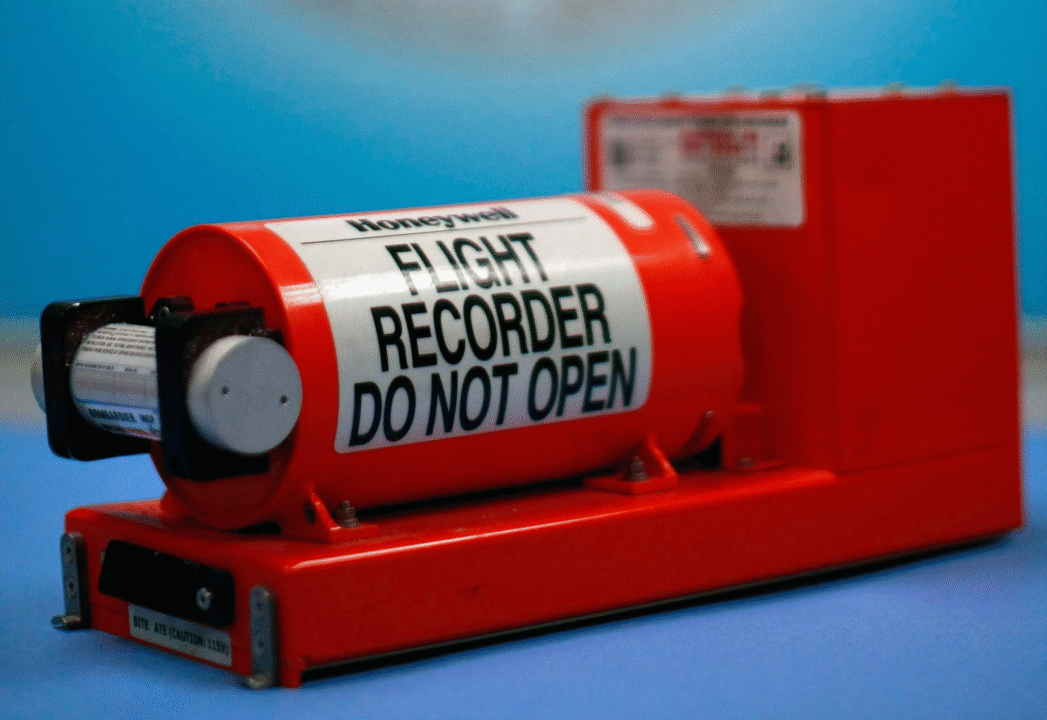A black box in an airplane is a vital electronic device used to record flight data and cockpit audio, especially during emergencies or accidents. Despite being called a “black box,” it’s actually bright orange to ensure easy visibility in debris. There are typically two black boxes on every commercial aircraft: the Flight Data Recorder (FDR) and the Cockpit Voice Recorder (CVR). Together, these devices help investigators understand what happened during a flight, particularly in the event of a crash.
How Does a Flight Black Box Work During a Crash?
During a flight, the black box continuously records crucial data such as altitude, airspeed, engine performance, and cockpit conversations. In the event of a crash, the device is built to survive extreme conditions such as high-impact forces, fire, and underwater submersion. The data stored in the black box can then be retrieved and analyzed to reconstruct the final moments before the incident.
Types of Black Boxes
There are two main types of black boxes used in aircraft:
- Flight Data Recorder (FDR): Records technical data about the aircraft’s operation, including altitude, speed, engine metrics, and control inputs.
- Cockpit Voice Recorder (CVR): Records all audio in the cockpit, including pilot conversations, alarms, and other background sounds.
Some modern aircraft use a combined unit that houses both the FDR and CVR in a single casing to simplify retrieval.
Mahindra NOVO 755 DI 4WD Tractor Overview
Why Is the Black Box Orange in Color?
The term “black box” is misleading. In reality, the devices are painted bright orange with reflective strips. This color makes them easier to locate in the aftermath of a crash, especially among wreckage and in challenging environments such as dense forests or deep waters.
Where Is the Black Box Located in an Aircraft?
The black box is usually located at the rear of the aircraft, in the tail section. This area is believed to be more likely to survive a crash because it often sustains less impact than the front. The placement maximizes the chances of retrieving intact data after an incident.
What Data Does a Flight Black Box Record?
The Flight Data Recorder can store over 80 different types of flight parameters, such as:
- Altitude and airspeed
- Vertical acceleration
- Heading and roll
- Engine thrust and performance
- Positions of control surfaces (like flaps and rudder)
The Cockpit Voice Recorder captures:
- Pilot and co-pilot conversations
- Communications with air traffic control
- Cockpit warnings and alarms
- Background noises (such as switch clicks or engine sounds)
This comprehensive data helps reconstruct the exact sequence of events before a crash.
How Black Boxes Help in Air Crash Investigations
After an accident, investigators recover the black box and extract the stored data. By analyzing the flight parameters and cockpit audio, they can:
- Determine the cause of the crash
- Identify possible mechanical or human errors
- Improve aviation safety by making policy or design changes
In many cases, black box data has led to critical improvements in pilot training, aircraft design, and operational procedures.
Can a Black Box Survive a Plane Crash or Fire?
Yes, black boxes are specifically engineered to withstand:
- Impact forces of up to 3,400 Gs
- Temperatures up to 1,100°C (2,012°F) for 30 minutes
- Water pressure at depths up to 20,000 feet
They are encased in titanium or stainless steel with heat-resistant insulation and a memory unit that protects recorded data even in extreme conditions.
History and Evolution of the Aircraft Black Box
The concept of the black box was developed in the 1950s by Australian scientist Dr. David Warren. His goal was to create a device that could explain why planes crashed, especially in unexplained accidents. The first black boxes were bulky and had limited recording capability.
Over time, these devices have evolved significantly:
- Digital recording replaced analog tape
- Recording capacity increased from minutes to hours
- Enhanced durability and underwater locator beacons were added
Modern black boxes are much more compact, reliable, and sophisticated.
Future of Flight Recorders
The aviation industry is gradually shifting toward digital and even real-time data streaming technologies. Some proposed advancements include:
- Cloud-based flight data backups
- Satellite-based real-time data transmission
- Miniaturized solid-state recorders with longer storage
These innovations could eliminate the need to physically recover black boxes after a crash, speeding up investigations and reducing data loss.
Conclusion
The black box is one of the most critical safety tools in modern aviation. Though often overlooked by passengers, these devices are at the heart of every major air crash investigation. As technology advances, we can expect even smarter, more durable, and possibly real-time black box solutions to emerge—making air travel even safer for everyone.
